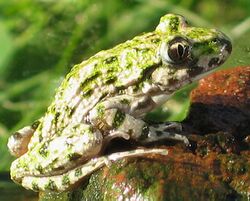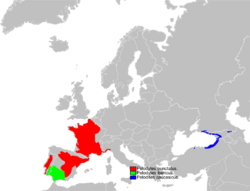Parsley frog
Topic: Biology
 From HandWiki - Reading time: 2 min
From HandWiki - Reading time: 2 min
| Parsley frog | |
|---|---|

| |
| Common parsley frog | |
| Scientific classification | |
| Domain: | Eukaryota |
| Kingdom: | Animalia |
| Phylum: | Chordata |
| Class: | Amphibia |
| Order: | Anura |
| Superfamily: | Pelobatoidea |
| Family: | Pelodytidae |
| Genus: | Pelodytes Bonaparte, 1838 |
| Species | |
|
See text | |

| |
| Distribution of Pelodytidae (in black) | |

| |
| Distribution of Pelodytidae | |
The parsley frogs or Pelodytidae are a family of order Anura. The family consists of a single genus, Pelodytes, which contains five species. These frogs can be found in south-western Europe and the Caucasus. The common name of "parsley frogs" comes from the common parsley frog which, because of its colouring, appears to be garnished with parsley.
Parsley frogs are typical-looking frogs closely related to European spadefoot toads and megophryids, but differ largely in appearance. Their cryptic colouring is not as strong as in many megophryids, but they are still quite well-camouflaged, usually being green or brown. Unlike the European spadefoot toads, they lack hardened protrusions on their feet, although they are still fossorial, and are generally slender.[1]
The parsley frogs are small, smooth-skinned frogs, reaching a length of 5 cm (2.0 in). They are one of the few families of frogs which contain more known extinct species and genera (two or three) than extant species. Although now found only in the Palearctic realm, fossils of a mid-Miocene species were also found in North America.[1]
Taxonomy
- Family Pelodytidae
- Genus Pelodytes
- Pelodytes atlanticus – Lusitanian parsley frog
- Pelodytes caucasicus – Caucasian parsley frog
- Pelodytes hespericus – Hesperides' parsley frog
- Pelodytes ibericus – Iberian parsley frog
- Pelodytes punctatus – Common parsley frog
- Genus Pelodytes
References
- ↑ 1.0 1.1 Zweifel, Richard G. (1998). Cogger, H.G.. ed. Encyclopedia of Reptiles and Amphibians. San Diego: Academic Press. pp. 88–89. ISBN 0-12-178560-2.
- Cogger, H.G.; R.G. Zweifel; D. Kirschner (2004). Encyclopedia of Reptiles & Amphibians Second Edition. Fog City Press. ISBN 1-877019-69-0.
- "ADW: Pelodytidae: Information". http://animaldiversity.ummz.umich.edu/site/accounts/information/Pelodytidae.html. Retrieved 2006-05-13.
Wikidata ☰ Q719414 entry
 |
 KSF
KSF